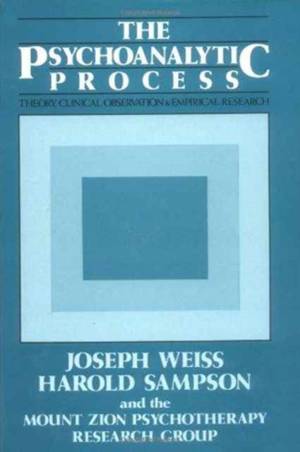
- Retrait gratuit dans votre magasin Club
- 7.000.000 titres dans notre catalogue
- Payer en toute sécurité
- Toujours un magasin près de chez vous
- Retrait gratuit dans votre magasin Club
- 7.000.0000 titres dans notre catalogue
- Payer en toute sécurité
- Toujours un magasin près de chez vous
The Psychoanalytic Process
Theory, Clinical Observation, and Empirical Research
Joseph Weiss, Harold Sampson
Livre relié | Anglais
72,95 €
+ 145 points
Description
In this landmark volume-- already acclaimed as "certain to become a milestone in the history of psychoanalysis and ego psychology"-- Joseph Weiss' theory of the psychotherapeutic process is presented and supported by the systematic, quantitative research carried out by Sampson, Weiss, and the Mount Zion Psychotherapy Research Group. This remarkable work delineates clear-cut implications for doing therapy and for conceptualizing the therapeutic process.
The theory extends and develops concepts that Freud introduced in his later writings. It assumes that psychopathology stems from certain grim, unconscious, pathogenic beliefs that the patient acquires by inference from early traumatic experiences. The patient suffers unconsciously from these beliefs and the feelings of guilt, shame, and remorse that stem from them. He is, therefore, powerfully motivated unconsciously to change them. Moreover, the patient is able to exert considerable control over unconscious mental life and, indeed, to make and carry out unconscious plans. He works unconsciously throughout his treatment to change pathogenic beliefs, both by testing them in relation to the analyst and by using insights conveyed by the analyst's interpretations.
Since the theory is close to observation it enables the clinician to monitor the patient's progress--to understand, throughout the treatment, how the patient improves, or is set back, by the analyst's interventions. The quantitative, empirical research presented bears directly on this theory. It offers strong evidence that the patient exerts control over the emergence of previously repressed mental contents, bringing them to consciousness when he unconsciously decides he may safely experience them. Supporting the hypothesis that the patient tests pathogenic beliefs throughout treatment in an effort to disconfirm them, it shows that the patient is very likely to respond favorably to interpretations that he can use in his struggle to disconfirm his pathogenic beliefs--but unfavorably to interpretations he cannot use for this purpose.
A model of how rigorous psychoanalytic research can both sharpen and modify theoretical constructs and also lend support to a clinical approach, this distinguished volume will be valued by theoreticians, clinicians, researchers, and anyone interested in how the mind works. It provides a clear, accessible, and empirically testable approach to psychoanalytic practice.
The theory extends and develops concepts that Freud introduced in his later writings. It assumes that psychopathology stems from certain grim, unconscious, pathogenic beliefs that the patient acquires by inference from early traumatic experiences. The patient suffers unconsciously from these beliefs and the feelings of guilt, shame, and remorse that stem from them. He is, therefore, powerfully motivated unconsciously to change them. Moreover, the patient is able to exert considerable control over unconscious mental life and, indeed, to make and carry out unconscious plans. He works unconsciously throughout his treatment to change pathogenic beliefs, both by testing them in relation to the analyst and by using insights conveyed by the analyst's interpretations.
Since the theory is close to observation it enables the clinician to monitor the patient's progress--to understand, throughout the treatment, how the patient improves, or is set back, by the analyst's interventions. The quantitative, empirical research presented bears directly on this theory. It offers strong evidence that the patient exerts control over the emergence of previously repressed mental contents, bringing them to consciousness when he unconsciously decides he may safely experience them. Supporting the hypothesis that the patient tests pathogenic beliefs throughout treatment in an effort to disconfirm them, it shows that the patient is very likely to respond favorably to interpretations that he can use in his struggle to disconfirm his pathogenic beliefs--but unfavorably to interpretations he cannot use for this purpose.
A model of how rigorous psychoanalytic research can both sharpen and modify theoretical constructs and also lend support to a clinical approach, this distinguished volume will be valued by theoreticians, clinicians, researchers, and anyone interested in how the mind works. It provides a clear, accessible, and empirically testable approach to psychoanalytic practice.
Spécifications
Parties prenantes
- Auteur(s) :
- Editeur:
Contenu
- Nombre de pages :
- 423
- Langue:
- Anglais
Caractéristiques
- EAN:
- 9780898626704
- Date de parution :
- 07-10-86
- Format:
- Livre relié
- Format numérique:
- Genaaid
- Dimensions :
- 152 mm x 229 mm
- Poids :
- 737 g

Les avis
Nous publions uniquement les avis qui respectent les conditions requises. Consultez nos conditions pour les avis.






